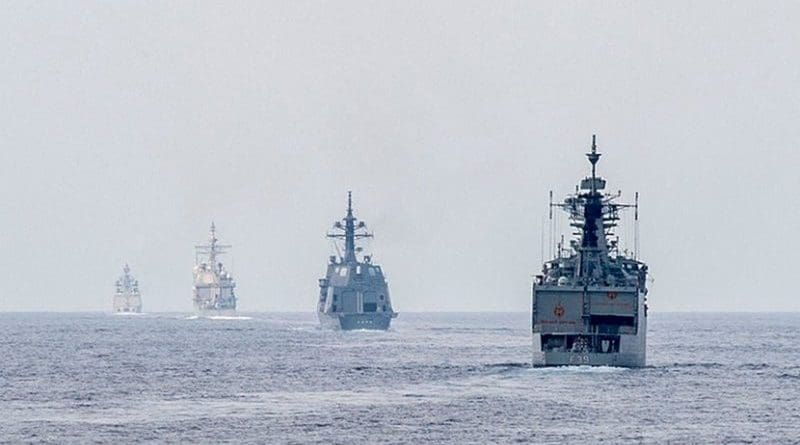Japan-Australia Defense Treaty: US Allies Adapting To New Geopolitics Of The Indo-Pacific
By Stephen Nagy
Japan and Australia have agreed in principle to a defense treaty that forms part of Tokyo’s three-pronged approach to security and engagement in the Indo-Pacific: 1) strengthening the US-Japan alliance; 2) cultivating new security partnerships; and 3) pragmatic engagement with Indo-Pacific countries through multilateral agreements in trade and infrastructure and connectivity under the Free and Open Indo-Pacific Vision (FOIP) rubric.
This agreement should be evaluated alongside the recent signing of the Regional Comprehensive Economic Partnership (RCEP), Japan’s critical leadership in successfully signing the Comprehensive and Progressive Agreement for Trans-Pacific Partnership (CPTPP), the recent QUAD meeting in October, and Japan’s engagement with the EU through the signing of the Japan-EU Economic Partnership Agreement (EPA), and the Japan-EU Infrastructure and Connectivity Initiative. These achievements represented a multifaceted approach to security that is meant to embed Japan in the Indo-pacific economic architecture while at the same time creating security partnerships with likeminded countries that can contribute to sustaining a rules-based Indo-Pacific region. In short, it blends engagement and hedging to manage an assertive China, time-honored concerns about abandonment, and the challenges of an intensifying US-China strategic competition.
The Reciprocal Access Agreement (RAA), signed as part of the Japan-Australia defense treaty, represents one of Tokyo’s core pillars for achieving its security objectives: forming deep, institutionalized security ties with likeminded countries. The treaty itself is significant as it marks the first time in Japan’s post-WWII history that it has formed such a security partnership with any state other than the U.S. since the Status of Forces agreement was signed in 1960.
Australian Prime Minister Scott Morrison and Japanese Prime Minister Yoshihide Suga highlighted that the longstanding Australian-Japanese partnership is not a marriage of convenience. Rather, it is a relationship that has been built on shared values and interests, and enduring trust and respect. Furthermore, it is a relationship that acknowledges past conflict between the two friends while clearly and mutually committing to building a shared future together. Both states are committed to their Special Strategic Partnership with a shared vision to buttress a free, open, inclusive, and stable Indo-Pacific region.
In principle, Japan and Australia have agreed to legally binding commitments such as how to deal with issues of criminal jurisdictions; claims for accidents; regulations and payments for visiting forces regarding supplies, taxation and import/export duties; refueling and munitions arrangements and payment for them, etc. The formal signing of the RAA final text will take place next year once more sensitive issues have been settled such as the application of death penalty to Australian service people in Japan. At this stage, both sides agreed to treat each case individually.
On a practical level, the treaty will serve to enhance inter-operability and cooperation between the Japanese Self-Defense Forces and the Australian military in the areas of traditional and non-traditional security issues such as HADR, search and rescue, and maritime domain awareness activities. It will do this by streamlining deployment procedures to maximize the speed and efficiency of deployment. With RAA, both states will be able to enhance their bilateral and multilateral exercises within the Trilateral Security Dialogue (TAD), the Malabar exercises, and the Rim of Pacific Exercise (RIMPAC).
Keen Sword exercises represent another arena of joint exercises that may be leveraged to deepen inter-operability. With Canadian warships also participating in these exercises, the new RAA presents an opportunity to further multilateralize joint exercises.
The new agreement also brings clarity to the nature of defense force cooperation in each other’s countries, serving to enhance understanding of each other’s comparative advantages and learn from deepened cooperation.
The RAA should be understood as the core platform for Japan-Australia partnership, and one that will provide a framework for security cooperation throughout the Indo-Pacific. Though it represents a landmark shift in Japan-Australia defense cooperation, it should be noted that this new treaty works synergistically with the pre-existing US-Japan alliance, and thus can be viewed as a concrete demonstration of US security partners proactively increasing their contributions to the Indo-Pacific region and displaying increased willingness to share the burden of supporting the regional security architecture. This serves to keep the U.S. anchored to the region and carve out agency, ensuring that the Indo-Pacific is not going to be solely shaped by the Sino-US strategic competition.
Notwithstanding this watershed moment, both Australia and Japan have not and will not take a zero-sum approach to their relations with China. Signing RCEP in the same week as the defense treaty highlights that both Canberra and Tokyo want to engage where and when they can with China. They want to use the defense treaty, the RCEP agreement, and the CPTPP, to send the strongest signal to Washington that realizing a Free and Open Indo-Pacific requires trade, infrastructure and connectivity, and security pillars.
The views expressed in this article are those of the authors alone and do not necessarily reflect those of Geopoliticalmonitor.com or any institutions with which the authors are associated.

